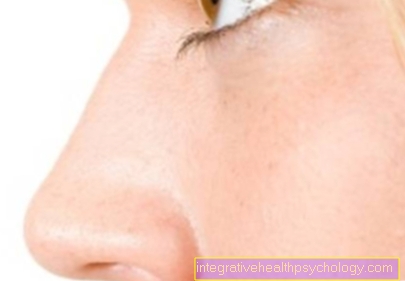Bursitis on the elbow
Synonyms
Olecranon bursitis, colloquial: students elbow (student elbow)
Definition
A Olecranon bursitis is a painful inflammation of the area just under the skin Bursa in the area of Elbowthat both septic, so with bacterial colonization, as well aseptic can run.
The diagnosis is usually made on the basis of clinical symptoms; the chances of recovery are very good with adequate therapy.
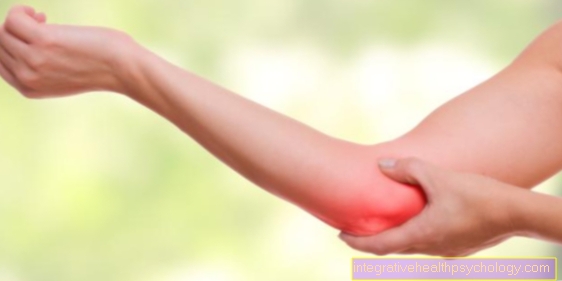
root cause
In the more common case, bursitis olecrani, i.e. inflammation of the bursae protecting the olecranon, occurs due to mechanical irritation from the outside; this form of bursitis is therefore atraumatic, i.e. without open injury from the outside.
The colloquial term "students elbow" suggests a frequent cause of irritation: Repeated prolonged leaning on the elbow when working at a desk can cause the bursa to become infected.
Read more on the topic: Inflammation of the elbow.
But an open injury can also be the cause. A bursitis caused by a puncture, cut or other open injury is usually septic (purulent), as the injury creates a portal for bacteria to enter.
In patients with reduced resistance, for example those whose immune system is weakened (suppressed) by chemotherapy or certain diseases, septic bursitis can develop without an open injury or through a very minor one.
Figure bursitis on the elbow

- Bursa
of the elbow -
Bursa subcutanea olecrani - Connective tissue layer -
Stratum fibrosum - Synovial layer -
Synovial stratum - elbow
(Approach of the arm extensor) -
Olecranon - Upper arm-ulnar joint -
Articulatio humeroulnaris - Upper arm shaft -
Corpus humeri - Spoke shaft -
Corpus radii - Ellschaft -
Corpus ulnae
A - bursa of the elbow
(Light blue) - normal
B - elbow - normal
C - bursitis
at the elbow - Olecranon bursitis
D. - Anatomy of the inflammation of a
Bursa on the elbow
You can find an overview of all Dr-Gumpert images at: medical illustrations
Appointment with an elbow expert?

I would be happy to advise you!
Who am I?
My name is dr. Nicolas Gumpert. I am a specialist in orthopedics and the founder of .
Various television programs and print media report regularly about my work. On HR television you can see me every 6 weeks live on "Hallo Hessen".
As a former performance-oriented tennis player, I specialized early on in the conservative treatment of the elbow.
You can find me in:
- Lumedis - your orthopedic surgeon
Kaiserstrasse 14
60311 Frankfurt am Main
Directly to the online appointment arrangement
Unfortunately, it is currently only possible to make an appointment with private health insurers. I hope for your understanding!
Further information about myself can be found at Dr. Nicolas Gumpert
Bursitis after a fall
To Fall on the elbow can it to Irritation of the bursa there come by squeezing it but keeping it locked.
This stimulus creates a more serious, so serum-like, effusion in the bursa, which depending on size at the elbow palpable or even visible is.
Of the Effusion presses on the bursa wall and thereby solves Pain and tenderness out.
As a result of the irritation of the bursa, there may be a further course after the fall aseptic bursitis come.
Therapeutically it should Elbows immobilized will and pain relievers or anti-inflammatory drugs to relieve the discomfort.
Of the Effusion usually occurs after a fall from the superficial cells in the bursa absorbed. As the effusion decreases, the symptoms and bursitis also decrease.
If the fall is a one-off event that irritates the bursa and it is not stressed in any other way, for example by repeatedly resting the elbow on the bursa, then it is no chronification the symptoms and permanent changes in the bursa tissue expected.
Symptoms
In both the septic and aseptic forms, the main symptom is a painful, burning swelling over the olecranon, which is usually very sensitive to touch.
The swelling is caused by the fact that an effusion, i.e. an accumulation of fluid, forms in the bursa as part of the inflammatory reaction; it can reach the size of a chicken egg.
In the case of the septic form, there is usually also redness and overheating, and there is often a greater sensitivity to touch. In this form of inflammation, the inflammation values in the blood are also noticeable (increase in the number of white blood cells = leukocytosis and increase in one of the inflammatory parameters, the C-reactive protein = CRP).
In addition, wounds in the elbow area indicate a bacterial origin.
Please also read the article on the topic Left forearm pain.
Pus in the bursa
The bursa on the elbow is a closed unit which is filled with a so-called synovial fluid, which the bursa itself produces and breaks down again.
Normally this liquid is clear and free from germs. However, if germs penetrate the bursa from outside, for example in the case of an open injury, they can then trigger a bacterial bursitis.
The side effect is a bulging, pain-sensitive and reddened elbow.
The body then provides white blood cells to defend against this inflammation. A form of white blood cell that "neutrophil granulocytes ", can then form pus, which consists of submerged cells.
If the bursa is punctured, the pus emerges as a cloudy, yellowish liquid with different consistencies.
In the case of bursitis with pus, this should always be removed, on the one hand to release the pressure and on the other hand to prevent the infection from spreading further.
Therapy is therefore either to puncture the bursa first and, if necessary, to remove it completely during an operation.
This should happen as quickly as possible to avoid the germs spreading into the bloodstream and the risk of blood poisoning.
Targeted antibiotic therapy (see also: antibiotics) can be used in conjunction with bacterial contamination of the surrounding tissue.
diagnosis
The diagnosis is made clinically, based on the symptoms described above. To rule out bony affections, a X-ray image otherwise the use of advanced imaging procedures is not the rule.
therapy
The aseptic form is usually used conservative, so treated non-surgically. cooling, local or systemic administration of anti-inflammatory drugs (Anti-inflammatory drugs) and possibly a temporary immobilization are the means of choice here.
If there is no significant improvement, the Surgically removed the bursa (Bursectomy).
When septic bursitis is always an operative removal are also usually carried out Antibiotics given or placed in the area of inflammation and removed a few days after the operation.
- more on the subject Bursitis Elbow Treatment
surgery
If bursitis of the elbow recurs frequently, or if there is severe bacterial inflammation, surgery can be considered to treat the symptoms.
Causes of repeated bursitis can be, for example, increased stress on the elbow due to movement or immunological processes in the body.
The bursa is located exactly between the elbow bone and the skin.
It has a cushioning and friction-reducing task that is useful but not essential to life.
This means that if it does more harm than good to the person affected by inflammation and pain, it can be removed.
If there is an acute inflammation of the bursa with a bacterial component, it is recommended to first puncture it in a small operation in order to drain the infectious fluid and to reduce the pressure and the associated pain of the bursa.
This slightly smaller procedure is usually followed by an open operation in which the bursa is completely removed.
Further information can be found under our topic: Operation of a bursa on the elbow
Even with one opened by an accident Bursa As with chronic bursitis on the elbow, surgery with removal of the corresponding tissue should be performed.
In order to avoid infections caused by the OP, you can as a precaution local antibiotic therapy are used during the operation in the form of a so-called antibiotic chain. Furthermore, sterile work in the operation of bursitis is, as always, of great importance in order to avoid postoperative problems.
As Access of the operation one chooses one straight cut just above the elbowwho as needed about 6 cm long and is seated in a bent arm position.
Then the bursa becomes exposed, from the surrounding tissue solved and taken.
Then the surgeon will examine it again for abnormalities.
The wound is then closed and with a Plaster splint supplied so that Joint immobilized and protected, and promoting problem-free healing.
After the operation, the patient should continue to protect the arm. This surgery of the bursitis can be done on an outpatient basis.
Since the procedure is relatively small and with few complications, it can be performed in Plexus anesthesia be performed. This means that the pain sensation of the arm is switched off specifically for the operation and the patient remains awake.
Nevertheless, the procedure of the operation is specially adapted to the needs of the patient and the severity of the bursitis. A Pain therapy in the form of medication can follow as needed.
In addition to the risk of infection, in addition to the general risks, there is also the possibility of the ulnar nerve (Ulnar nerve), which is anatomically close to the bursa.
Taping
To Treatment of a simple, that is, non-bacterial, Bursitis at the elbow it can Taping of the corresponding joint.
There while taping the underlying tissue is lifted by the special adhesive tape becomes, becomes a special stimulus and partly also one massaging effect triggered. This activates the tissue around the bursa and the bursa itself, and the body's own self-healing promoted at the point.
The reasons for this include a increased blood and lymph flow and associated with it an increased metabolism, which in total the Shut down inflammation should.
The tape will with arm bent right on the elbow applied fanned out and then fixed in a stretched position with a certain amount of tension.
It is important that the Joint not restricted in its freedom of movement will, because the Move is Part of the therapy concept.
Of the Advantage when taping is that it simply attached and corrected if the tape does not fit correctly. In addition, thanks to its flat texture, it offers a high wearing comfort, can also be worn while swimming and showering without slipping, and at the same time effectively stimulates the bursa.
After taping, the tape can left for about seven days then it should be renewed to maintain the effect until symptom-free.
What helps?
As a rule, bursitis heals on its own after a few weeks.Nevertheless, you can get some relief with a few aids. The general rule is: cooling before heat. Heat treatment should be avoided in the case of bursitis. Cold, on the other hand, can improve the pain, for example by applying ice packs. These should be put in a tea towel or similar beforehand. as otherwise they are too cold and can lead to frostbite. There are also cooling ointments that can also help relieve the pain.
Immobilization: Splints and bandages that can be used to temporarily immobilize the joint can be purchased at the pharmacy. However, this should not be the case permanently, as targeted movements, for example in physiotherapy, promote faster healing of the inflammation and the maintenance of mobility. Otherwise there may be functional losses.
Home remedies: Quark compresses have proven to be the most effective home remedy for bursitis. Quark cools, has anti-inflammatory effects and relieves pain. The cooled quark is placed on a tea towel and spread a little so that the layer is about half a centimeter thick. Then the cloth is wrapped and placed with the quark side on the elbow. The whole thing can be repeated several times a day for about half an hour to three quarters of an hour (until the quark is warm). Flaxseed compresses can also provide relief. To do this, bring the flaxseed to a boil until it starts to get slimy. After it cools, it can be applied to a cotton cloth and placed around the sore elbow. This wrap is best applied in the evening so that it can work overnight. In any case, a temporary immobilization of the elbow is recommended, but the joint should be mobilized again at an early stage so as not to impair its functionality permanently.
homeopathy: Potassium chloratum can be used in the homeopathic area to treat bursitis. This is a preparation of the alkali metal potassium chloride. It is available as Schüssler Salt No. 4 or in the form of globules of various potency. It is recommended to take potassium chloratum in the potency D4, D6 or D12 three times a day of five globules. In the case of acute symptoms, the preparation can also be taken every two hours. However, this should only be done until the symptoms improve. A higher dosage is not advisable for self-medication. Potassium chloratum is also available as an ointment made from Schüssler's No. 4 salt and can thus be applied directly to the inflamed area. However, if the symptoms persist or worsen, a doctor should be consulted for further clarification.
Ointment: Some ointments can also provide relief from the symptoms. Cooling ointments relieve pain, and ointments with anti-inflammatory drugs reduce inflammation. There are various suitable preparations, e.g. Ointments with diclofenac (Voltaren gel), acetylsalicylic acid or ibuprofen.
If the pain persists or worsens, however, self-medication should be avoided and a doctor should be consulted, who will then decide on further therapy.
Sports: The bursae can become inflamed, especially during sporting activity that requires a lot of stress on the elbow. Sports where this is more common include golf, tennis, baseball, and handball. Primarily, more stressful activities should be avoided in the case of acute bursitis.
Therapy is initially carried out by immobilizing the elbow and taking pain-relieving medication. However, after the acute symptoms have subsided, it is advisable to use targeted mobilization to maintain mobility in the affected joint, e.g. through guidance from a physiotherapist. Therefore, doctors often prescribe physiotherapy for bursitis.
You might also be interested in: How long will my bursitis last?
forecast
The therapeutic approach promises good chances of recovery, recurring complaints (Recurrences) due to newly formed bursa can occur.
anatomy
The Olecranon is the rear (dorsal) Part of the Cubit (Ulna) and forms the bone protrusion popularly known as the elbow on the back of the transition from the Upper- to the forearm.
Since the bone lies close to the surface of the skin and is hardly protected by subcutaneous (i.e., under the skin) fatty tissue, it is - like many other such bony protrusions in the body - by a Bursa a little way ahead external influences and overloads protected.



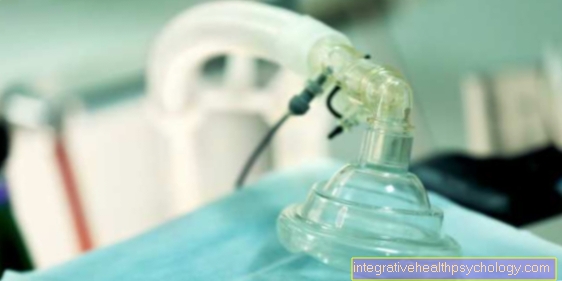

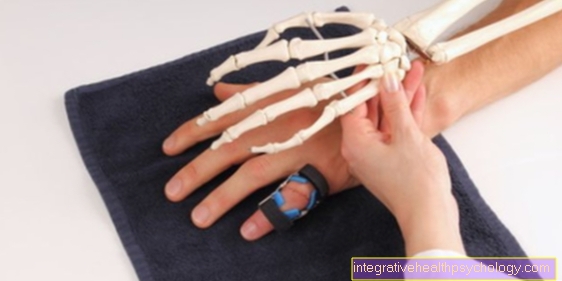



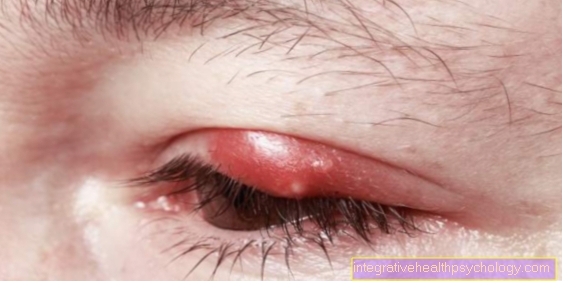

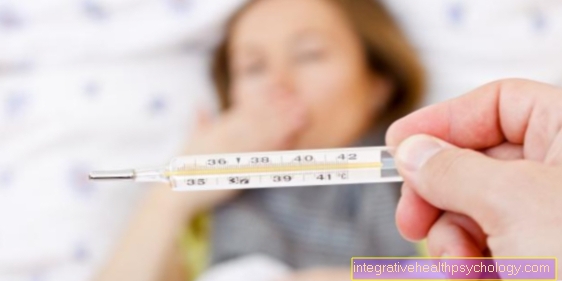

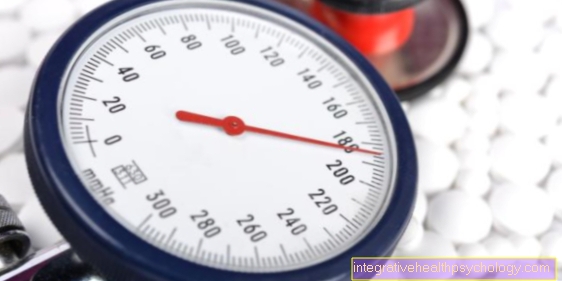

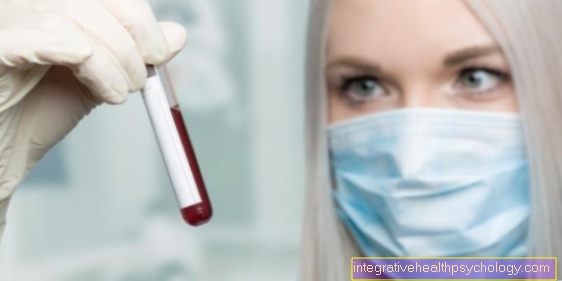

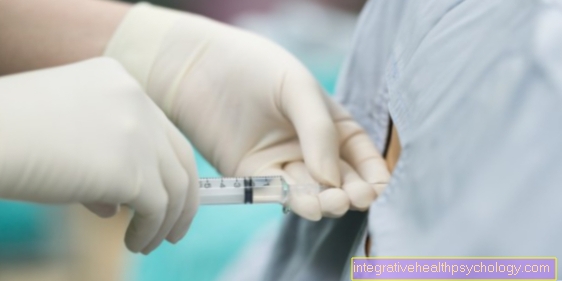

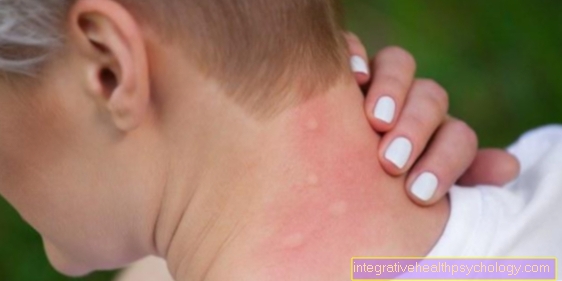

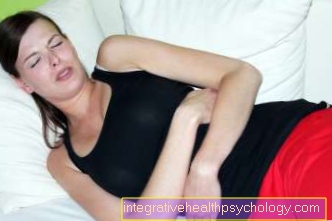

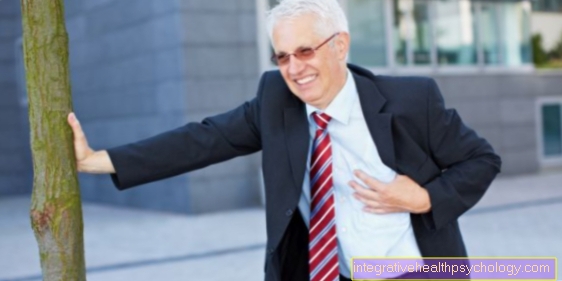

.jpg)

